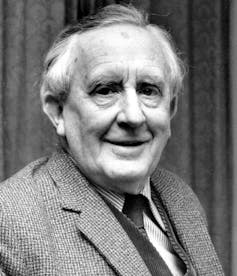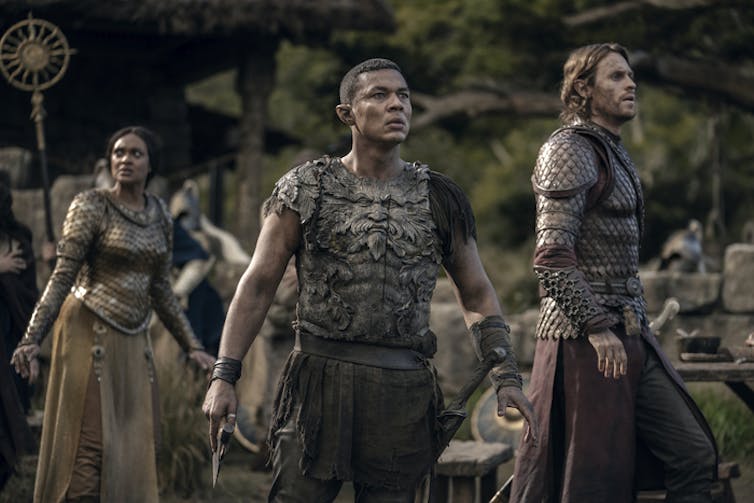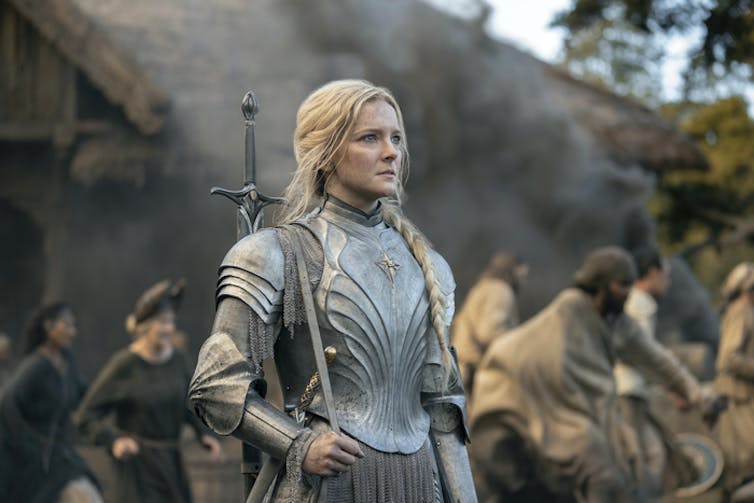
Amazon Prime’s billion-dollar production of The Lord of the Rings: The Rings of Power has been targeted with a flood of racist and misogynist abuse online.
Amazon disabled reviews for the shows due to “review bombing” — when online users seek to overwhelm reviews based on political agendas. Online commenters have both criticized the casting of people of colour and how the story focuses on powerful women.
Literature scholar Craig Franson has been researching the culture wars and neo-fascist politics in Tolkien studies. In a podcast he hosts with historian Dani Holtz, an expert in American conservatism, they discuss how online fascists use mass media “to harness blockbuster cultural productions,” as in the far-right backlash to Amazon’s Rings of Power series.
As a literature scholar who has studied Tolkien’s fiction and scholarly writings, I encourage discussions of adaptations to gain a better understanding of how they respond to Tolkien’s works and the world we live in today.
But far-right commenters have tried to shut down any discussion of a new re-telling that is not to their liking. A better understanding of Tolkien’s works and the nature of adaptations will combat some of the online disinformation and harassment campaign.
‘Faithful’ adaptation?
Long before the first episode aired Sept. 1, some commenters condemned the show because they assumed it would not be “faithful” to “the lore,” meaning the texts Tolkien wrote.
There is no such thing as a “faithful” adaptation in all details. As literary scholar Linda Hutcheon has pointed out, every adaptation is a re-interpretation of source material.
Far-right commenters use “Tolkien” as an image of the world they want to have: a male-dominated, all-white society, and they attack any other interpretations. Legitimate literary discussion therefore is threatened with being overwhelmed by intimidation and disinformation.
In this way, they can influence even those fans who are new to Tolkien or ideas about adaptation. Let’s take a look at some of the most popular misconceptions circulating now.
Much has to be invented
The purpose of an adaptation may be to pay homage to the source or to critique it, but either way it will say something new as a re-telling of a story.
Producing an adaptation in a new medium such as a TV show requires a different way of telling a story compared to a print version.
For Rings of Power, much has to be invented. With the approval of the Tolkien estate, Amazon has bought the rights to tell a story of the second age of Middle-earth based on the appendices in The Lord of the Rings.
In these appendices, Tolkien only briefly outlined what happened in Middle-earth before the events chronicled in The Lord of the Rings.
Did Tolkien ‘hate adaptations’?

Far-right commenters like to claim they know Tolkien’s mind and that he would disapprove of the Amazon adaptation because it does not represent an all-white cast of male heroes. But we simply cannot know what Tolkien would have thought of this current adaptation.
Another frequent claim is that Tolkien hated all adaptations. But Tolkien’s criteria for approval can be summed up in his own words: “Art or Cash.” In a letter to his son Christopher, Tolkien said he and his publisher Stanley Unwin had agreed on a policy of approving adaptations if either the author had a veto on objectionable features — or if they were very profitable.
Whether Tolkien would like the Amazon adaptation or not, his stories have opened up an expansive mythology that has already been adapted for decades by filmmakers, artists, game designers, musicians, cosplayers, fiction writers and others.
Purposeful retelling
One of the far-right’s repeated white supremacist claims is that Tolkien was representing the European Middle Ages and therefore his characters should be white. But the Middle Ages in Europe included people of colour, as examinations of the historical evidence have pointed out.
Helen Young, a literature scholar who examines race and whiteness in popular culture, explores how popular western fantasy writers and readers assumed the “good” characters were white.
Others point to details like the hobbit Sam being described as having “brown hands” or the Harfoot hobbits being “browner of skin” as a sign that audiences need not imagine hobbits as white. Creators can elaborate on such hints in Tolkien’s work, but they can also imagine this fantasy world in any way they choose.
Tolkien: Complex attitudes to race
Tolkien’s attitudes to race and racism were complex, as literary scholar Dimitra Fimi explains.
Although Tolkien made statements against racism and antisemitism in his letters, he based his work on racist hierarchies and medieval racial stereotypes.
Some adaptations might prefer to emphasize how The Lord of the Rings depicts “races,” such as hobbits, elves and dwarves, who bridge their differences to find common aims.
Ismael Cruz Córdova, a Black Latino actor who plays the elf Arondir in the Amazon series, posted about how it is important to “see ourselves, to imagine ourselves and to occupy the spaces that we rightfully deserved.”

Too much emphasis on women?
Even before the first episode aired, some commenters repeatedly complained about “warrior Galadriel” based on promotional photos. Many expected to see the ethereal lady of Peter Jackson’s movies or simply hated her image as a female military leader.
But this current adaptation portrays the younger Galadriel that Tolkien hinted at in some versions — ambitious, athletic and a fierce fighter.
Contrary to far-right expectations that an epic story should praise white male heroes, Rings of Power puts women at the centre in every story line without eliminating male leaders and warriors.

Productive questions
Tolkien is not above negative criticism. Neither is any adaptation. We can ask productive questions about the purpose and methods of adaptation and the corporation funding it.
Tolkien readers hold a broad range of views, and they won’t all agree when discussing the creative choices in this particular adaptation.
But prejudging it based on far-right talking points harms people, weakens our democratic social discourse, and will not lead to a better understanding of adaptation. We must certainly draw the line at engaging with racist and misogynist disinformation and abuse.
Anna Smol receives funding from the Social Sciences and Humanities Research Council of Canada.
This article was originally published on The Conversation. Read the original article.






